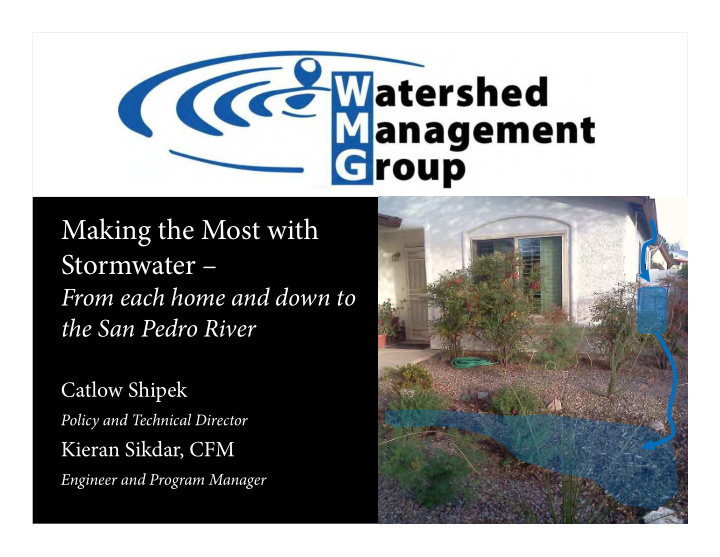



Making the Most with Stormwater – From each home and down to the San Pedro River Catlow Shipek Policy and Technical Director Kieran Sikdar, CFM Engineer and Program Manager
Watershed Management Group develops and implements community ‐ based solutions to ensure the long ‐ term prosperity of people and health of the environment . We provide people with the knowledge, skills, and resources for sustainable livelihoods.
Developing an Action Plan Purpose: • Promote Health of San Pedro River • Reduce groundwater demand • Enhance recharge • Promote Health of Community • Economic prosperity • Shade & beautify • Reduce nuisance flooding
Stormwater Utilization Opportunities Enhanced Urban Demand Reduction – Enhanced Recharge – Recharge – Direct Low Impact Geomorphic Restoration Recharge Facility Development Practices Treatments
Stormwater Utilization Opportunities Demand Reduction – Low Impact Development Practices
WMG’s Living Lab and Learning Center
LID demonstrated @Cochise College
LID Demonstrated @McFadden Park
LID Demonstrated @ Sierra Vista City Hall
Potential LID Demonstration @ along Garden Ave Fry Blvd Main Gate Entrance
Woodcutter Wash Hydrologic Modeling of LID Scenario Scenario: 10% LID adoption of small scale distributed features included retrofits of: residential • landscapes • commercial landscapes • parking areas, and street rights ‐ of ‐ • way 4” ponding basin depth (assume no infiltration during rain event) 2 year, 6 hour rain
Woodcutter Wash Hydrologic Modeling of LID Scenario Scenario: 10% LID adoption of small scale distributed features included retrofits of: residential • landscapes • commercial landscapes • parking areas, and street rights ‐ of ‐ • way 4” ponding basin depth (assume no infiltration during rain event) 2 year, 6 hour rain
Woodcutter Wash Hydrologic Modeling of LID Scenario Scenario: 10% LID adoption of small scale distributed features included retrofits of: residential • landscapes • commercial landscapes • parking areas, and street rights ‐ of ‐ • way 4” ponding basin depth (assume no infiltration during rain event) 2 year, 6 hour rain
Cost Benefit Analysis (CBA) Costs Benefit/Cost Ratio: Installation and maintenance Bigger is BETTER! Benefits $3-6 Benefit / $1 Cost Based on the volume of water harvested and the number of trees planted.
Summary of LID policy opportunities • Route stormwater to sunken landscape areas before being discharged offsite. • Retain the 15 minute 95% rainfall event on ‐ site (~0.5”) • Infiltrate collected water within 24hrs • Utilize and maintain vegetation, low ‐ water use native plants, as a functional element of the stormwater harvesting system • Water harvesting practices to meet on ‐ site irrigation demand • Develop funding mechanism for LID retrofits and adoption incentives
Stormwater Utilization Opportunities Demand Reduction – Enhanced Recharge – Low Impact Geomorphic Restoration Development Practices Treatments
Channel Erosion and Concept Design • Analyze stability of the wash. • Suggest methods for correcting erosion problems. • Evaluate opportunities for managed groundwater recharge (MGR).
Grade Control and Erosion • Analyze stability of the wash. • Suggest methods for correcting erosion problems. • Evaluate opportunities for managed groundwater recharge (MGR).
Design Concept to re ‐ route upland flows • Analyze stability of the wash. • Suggest methods for correcting erosion problems. • Evaluate opportunities for managed groundwater recharge (MGR).
Location: San Vicente Creek, Silver City, NM Built for a 100yr (8600cfs) Image credit: Stream Dynamics event with a 1.5 ‐ 2 design safety factor • Protects a sewer main Controls grade • • Promotes riparian vegetation for long ‐ term natural stability Image credit: Stream Dynamics
Image credit: Stream Dynamics
Natural Channel Design for Enhanced Recharge • Identify areas with greater permeability • Use features that promote streambed infiltration and bank storage • Mimic channel bed slopes and fluvial structure of stable reaches • Tie projects to additional community benefits: bike/pathways, protecting infrastructure, promoting riparian vegetation and wildlife,…
Stormwater Utilization Opportunities Enhanced Urban Demand Reduction – Enhanced Recharge – Recharge – Direct Low Impact Geomorphic Restoration Recharge Facility Development Practices Treatments
Tackling the Water Deficit Sierra Vista Subwatershed MODEL PARAMETERS Fixed Parameters Demand Impacts on Deficit Assumption - Adoption by Channel Portion Other Treated to Three Percentage SV home of Sierra Vista Population Scenario of Supply RWH and GPCD Rate Demand Enhance Urban Growth Rate Timeframes relative to efficiency of Change Change per Stream per year (fixed, not current use Change per per year year Recharge for (assumed) variables in (assumed) year (assumed) (assumed) Sierra Vista this model) (Assumed) (assumed) Phase 1: Early 2015-2020 100% 0.0% 5.0% -6.0% -2.0% 10.0% adopters Phase 2: Moderate 2021-2025 100% 2.0% 10.0% -4.0% -2.0% 10.0% adopters Phase 3: Majority 2026-2030 100% 2.0% 10.0% -4.0% -2.0% 0.0% adopted
Recommend
More recommend